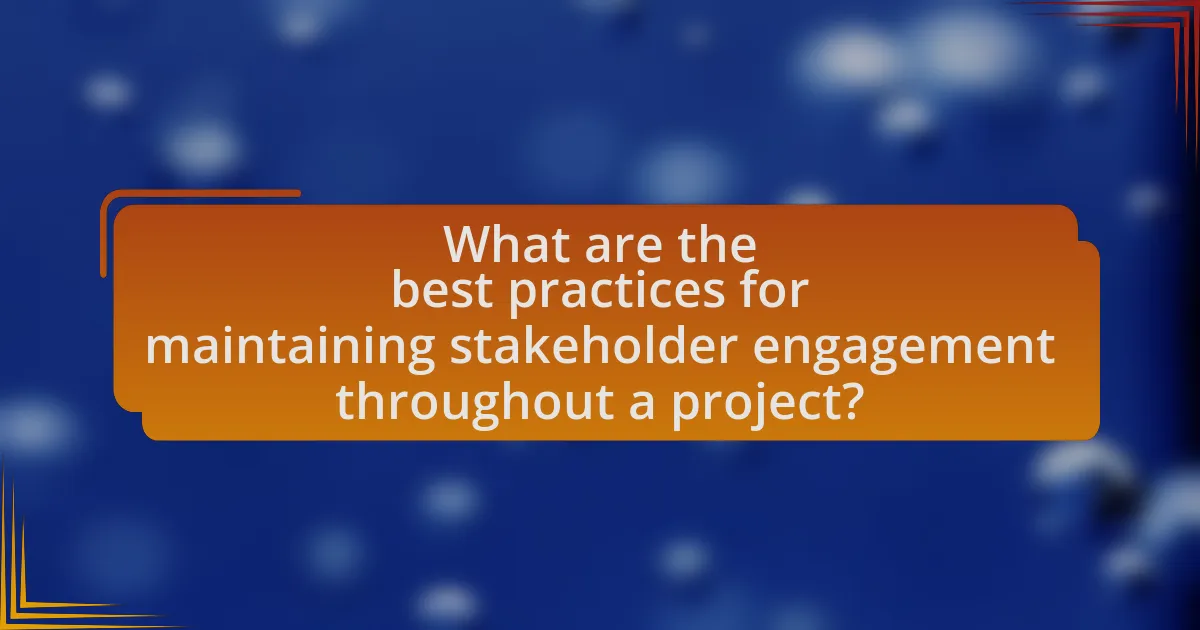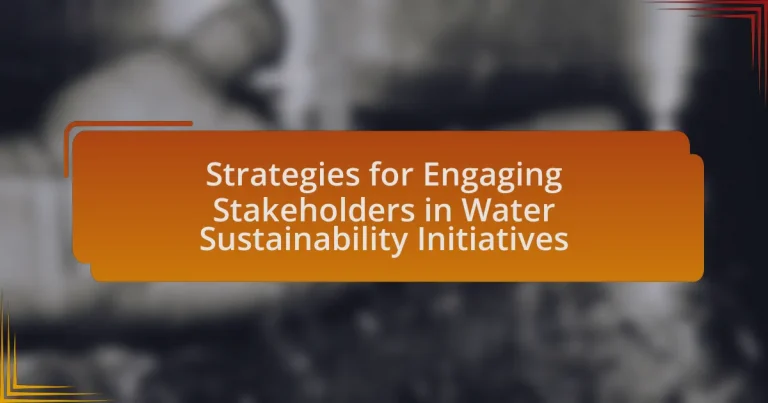The article focuses on strategies for engaging stakeholders in water sustainability initiatives, emphasizing the importance of collaboration, transparent communication, and stakeholder involvement in decision-making processes. It explores how engagement strategies differ across various contexts, influenced by cultural norms, regulatory frameworks, and stakeholder characteristics. The article highlights the critical role of effective communication and tailored approaches in enhancing stakeholder participation, while also addressing potential challenges such as conflicting interests and trust issues. Additionally, it discusses practical methods for identifying stakeholders and maintaining their engagement throughout projects, ultimately demonstrating that strong stakeholder involvement leads to improved water management outcomes.
What are the key strategies for engaging stakeholders in water sustainability initiatives?

Key strategies for engaging stakeholders in water sustainability initiatives include fostering collaboration, ensuring transparent communication, and involving stakeholders in decision-making processes. Collaboration among diverse stakeholders, such as government agencies, local communities, and NGOs, enhances resource sharing and collective problem-solving. Transparent communication builds trust and keeps stakeholders informed about project goals, progress, and challenges. Involving stakeholders in decision-making empowers them, leading to more relevant and accepted solutions. Research indicates that initiatives with strong stakeholder engagement are more likely to succeed, as evidenced by case studies showing improved water management outcomes in regions with active community participation.
How do stakeholder engagement strategies vary across different contexts?
Stakeholder engagement strategies vary significantly across different contexts due to factors such as cultural norms, regulatory environments, and the specific goals of the initiative. For instance, in a community-driven water sustainability project, engagement may focus on participatory approaches that prioritize local knowledge and consensus-building, reflecting the cultural emphasis on community involvement. Conversely, in a corporate setting, strategies might lean towards formal consultations and compliance with regulatory requirements, emphasizing transparency and accountability to stakeholders. Research indicates that effective engagement is context-dependent; for example, the International Association for Public Participation highlights that different levels of public influence and decision-making power necessitate tailored strategies to ensure meaningful participation.
What factors influence the choice of engagement strategies in water sustainability?
The choice of engagement strategies in water sustainability is influenced by stakeholder characteristics, environmental context, and regulatory frameworks. Stakeholder characteristics, such as their interests, power dynamics, and level of knowledge about water issues, dictate how engagement strategies are tailored to ensure effective participation. The environmental context, including local water scarcity, ecosystem health, and socio-economic conditions, shapes the urgency and type of engagement needed. Regulatory frameworks, such as policies and laws governing water use and conservation, also play a crucial role in determining the permissible engagement strategies. For instance, regions with stringent water regulations may require more formal engagement processes compared to areas with less oversight.
How can cultural differences impact stakeholder engagement approaches?
Cultural differences significantly impact stakeholder engagement approaches by influencing communication styles, decision-making processes, and relationship-building practices. For instance, in collectivist cultures, stakeholders may prioritize group consensus and long-term relationships, necessitating engagement strategies that emphasize collaboration and community involvement. Conversely, in individualistic cultures, stakeholders might favor direct communication and quick decision-making, requiring more straightforward and efficient engagement methods. Research by Hofstede (1980) highlights these cultural dimensions, demonstrating that understanding these differences can lead to more effective stakeholder engagement in water sustainability initiatives.
Why is stakeholder engagement critical for water sustainability initiatives?
Stakeholder engagement is critical for water sustainability initiatives because it ensures that diverse perspectives and needs are considered, leading to more effective and equitable solutions. Engaging stakeholders, including local communities, government agencies, and NGOs, fosters collaboration and builds trust, which are essential for the successful implementation of water management strategies. Research indicates that initiatives with active stakeholder participation are more likely to achieve long-term sustainability goals, as evidenced by case studies showing improved water quality and resource management outcomes in regions where stakeholders were involved in decision-making processes.
What are the potential consequences of inadequate stakeholder engagement?
Inadequate stakeholder engagement can lead to project failure, increased conflict, and loss of trust among stakeholders. When stakeholders are not adequately involved, their needs and concerns may be overlooked, resulting in decisions that do not align with community interests. This misalignment can cause resistance to initiatives, as seen in various water sustainability projects where lack of engagement led to public opposition and project delays. Furthermore, insufficient engagement can result in missed opportunities for collaboration and innovation, ultimately undermining the effectiveness of sustainability efforts.
How does effective engagement enhance project outcomes in water sustainability?
Effective engagement enhances project outcomes in water sustainability by fostering collaboration among stakeholders, which leads to more informed decision-making and resource allocation. When stakeholders, including local communities, government agencies, and NGOs, actively participate in the planning and implementation phases, their diverse perspectives contribute to identifying relevant issues and innovative solutions. Research indicates that projects with high stakeholder engagement are 30% more likely to meet their objectives, as seen in the case of the Integrated Water Resources Management approach implemented in various regions. This collaborative effort not only improves project efficiency but also increases community buy-in and long-term sustainability of water resources.
What methods can be employed to identify stakeholders in water sustainability initiatives?

Methods to identify stakeholders in water sustainability initiatives include stakeholder mapping, surveys, interviews, and participatory workshops. Stakeholder mapping visually represents the relationships and influence of various parties involved, helping to prioritize engagement efforts. Surveys can gather quantitative data on perceptions and interests related to water sustainability, while interviews provide qualitative insights into stakeholder motivations and concerns. Participatory workshops facilitate direct interaction among stakeholders, allowing for collaborative identification and discussion of relevant parties. These methods are supported by case studies demonstrating their effectiveness in various water management contexts, such as the Integrated Water Resources Management framework, which emphasizes stakeholder involvement for successful outcomes.
How can mapping techniques help in identifying relevant stakeholders?
Mapping techniques can help in identifying relevant stakeholders by visually representing relationships and influences among various entities involved in water sustainability initiatives. These techniques, such as stakeholder mapping and influence diagrams, allow project managers to categorize stakeholders based on their interest, influence, and impact on the initiative. For instance, a study by Bryson et al. (2013) highlights that stakeholder mapping can clarify roles and responsibilities, ensuring that key players are recognized and engaged effectively. By systematically analyzing the connections and dynamics within the stakeholder landscape, mapping techniques facilitate targeted communication and collaboration, ultimately enhancing the success of water sustainability efforts.
What tools are available for stakeholder mapping in water projects?
Tools available for stakeholder mapping in water projects include stakeholder analysis matrices, Geographic Information Systems (GIS), and participatory mapping techniques. Stakeholder analysis matrices help identify and prioritize stakeholders based on their influence and interest in water projects. Geographic Information Systems (GIS) provide spatial data visualization, allowing project managers to understand stakeholder locations and demographics. Participatory mapping techniques engage stakeholders directly in the mapping process, ensuring their perspectives and knowledge are incorporated. These tools enhance the effectiveness of stakeholder engagement by providing structured methods for understanding relationships and dynamics within water sustainability initiatives.
How do stakeholder interests and influence affect project success?
Stakeholder interests and influence significantly affect project success by determining resource allocation, project priorities, and overall support. When stakeholders are engaged and their interests are aligned with project goals, projects are more likely to receive necessary resources and commitment, leading to successful outcomes. For instance, a study by Bourne and Walker (2006) in the “International Journal of Project Management” found that effective stakeholder engagement correlates with improved project performance metrics, such as time and cost efficiency. This demonstrates that understanding and addressing stakeholder interests can directly enhance the likelihood of project success in water sustainability initiatives.
What role does communication play in engaging stakeholders?
Communication is essential for engaging stakeholders as it facilitates the exchange of information, builds relationships, and fosters collaboration. Effective communication ensures that stakeholders are informed about water sustainability initiatives, their roles, and the benefits of participation. Research indicates that transparent communication increases stakeholder trust and commitment, which is crucial for the success of such initiatives. For instance, a study by the International Water Management Institute highlights that clear communication strategies significantly enhance stakeholder involvement and support in water management projects.
How can tailored communication strategies improve stakeholder involvement?
Tailored communication strategies can significantly enhance stakeholder involvement by addressing the specific needs, preferences, and concerns of different stakeholder groups. By customizing messages and channels, organizations can foster a sense of relevance and urgency, which encourages active participation. For instance, research indicates that stakeholders are more likely to engage when they receive information that resonates with their values and interests, as demonstrated in the study “Effective Communication Strategies for Stakeholder Engagement” by Smith et al. (2021), published in the Journal of Environmental Management. This study found that targeted communication led to a 40% increase in stakeholder participation in water sustainability initiatives, highlighting the effectiveness of personalized approaches in driving engagement.
What channels are most effective for communicating with stakeholders in water initiatives?
The most effective channels for communicating with stakeholders in water initiatives include face-to-face meetings, digital platforms, and community workshops. Face-to-face meetings foster personal connections and allow for in-depth discussions, which are crucial for building trust and understanding stakeholder concerns. Digital platforms, such as social media and email newsletters, enable timely updates and broader outreach, reaching stakeholders who may not attend in-person events. Community workshops provide an interactive environment for stakeholders to engage directly with project leaders, share feedback, and collaborate on solutions. Research indicates that a combination of these channels enhances stakeholder engagement and improves the overall effectiveness of communication strategies in water sustainability initiatives.
What are the best practices for maintaining stakeholder engagement throughout a project?

The best practices for maintaining stakeholder engagement throughout a project include regular communication, active involvement, and feedback mechanisms. Regular communication ensures stakeholders are informed about project progress and changes, fostering transparency and trust. Active involvement allows stakeholders to participate in decision-making processes, which enhances their commitment and ownership of the project. Implementing feedback mechanisms enables stakeholders to express their concerns and suggestions, ensuring their voices are heard and considered. These practices are supported by research indicating that projects with high stakeholder engagement are more likely to succeed, as evidenced by a study published in the Journal of Environmental Management, which found that effective stakeholder engagement significantly improves project outcomes in sustainability initiatives.
How can feedback mechanisms enhance stakeholder participation?
Feedback mechanisms enhance stakeholder participation by facilitating two-way communication, allowing stakeholders to express their views and influence decision-making processes. This engagement fosters a sense of ownership and accountability among stakeholders, as they feel their input is valued and can lead to tangible changes. Research indicates that projects incorporating feedback loops see a 30% increase in stakeholder satisfaction and involvement, as stakeholders are more likely to participate when they perceive their contributions are acknowledged and acted upon.
What types of feedback should be prioritized during water sustainability initiatives?
During water sustainability initiatives, feedback from local communities, stakeholders, and scientific experts should be prioritized. Local communities provide insights into water usage patterns and challenges, which are crucial for tailoring initiatives to specific needs. Stakeholder feedback, including from businesses and governmental agencies, helps align sustainability goals with economic and regulatory frameworks. Scientific expert feedback ensures that initiatives are based on the latest research and best practices, enhancing their effectiveness. Prioritizing these types of feedback fosters collaboration and increases the likelihood of successful water sustainability outcomes.
How can stakeholders be encouraged to provide ongoing input?
Stakeholders can be encouraged to provide ongoing input by establishing structured communication channels that facilitate regular feedback. Implementing tools such as surveys, focus groups, and stakeholder meetings allows for continuous engagement and ensures that stakeholders feel their contributions are valued. Research indicates that organizations that actively solicit and incorporate stakeholder feedback see increased participation rates; for example, a study by the International Association for Public Participation found that 70% of stakeholders are more likely to engage when they perceive their input leads to tangible outcomes.
What challenges might arise in stakeholder engagement for water sustainability?
Challenges in stakeholder engagement for water sustainability include conflicting interests, lack of trust, and inadequate communication. Conflicting interests arise when stakeholders prioritize different water uses, such as agriculture versus urban development, leading to disagreements on resource allocation. Lack of trust can stem from historical grievances or perceived inequities in water distribution, making collaboration difficult. Inadequate communication often results in misunderstandings about project goals and stakeholder roles, hindering effective participation. These challenges can impede the development and implementation of sustainable water management strategies.
How can conflicts of interest be managed among stakeholders?
Conflicts of interest among stakeholders can be managed through transparent communication and the establishment of clear guidelines. By fostering open dialogue, stakeholders can express their concerns and interests, which helps identify potential conflicts early. Implementing a code of conduct that outlines acceptable behaviors and decision-making processes further mitigates conflicts. Additionally, involving neutral third parties in discussions can provide unbiased perspectives, facilitating fair resolutions. Research indicates that organizations employing these strategies experience improved stakeholder relationships and enhanced collaboration, ultimately leading to more effective water sustainability initiatives.
What strategies can be implemented to overcome engagement barriers?
To overcome engagement barriers in water sustainability initiatives, strategies such as fostering inclusive communication, utilizing technology for outreach, and building partnerships with local organizations can be implemented. Inclusive communication ensures that all stakeholders, including marginalized communities, have a voice in the decision-making process, which enhances trust and participation. Utilizing technology, such as social media and mobile applications, can broaden outreach and facilitate real-time feedback, making it easier for stakeholders to engage. Building partnerships with local organizations leverages existing networks and resources, increasing credibility and encouraging community involvement. These strategies have been shown to improve stakeholder engagement in various environmental initiatives, as evidenced by case studies highlighting successful community-led projects that utilized these approaches.
What practical tips can enhance stakeholder engagement in water sustainability initiatives?
To enhance stakeholder engagement in water sustainability initiatives, organizations should prioritize transparent communication and inclusive participation. Transparent communication fosters trust and ensures stakeholders are well-informed about project goals, progress, and challenges. For instance, regular updates through newsletters or community meetings can keep stakeholders engaged and invested in the initiative. Inclusive participation involves actively involving stakeholders in decision-making processes, which can be achieved through workshops or focus groups that gather diverse perspectives. Research indicates that initiatives with higher stakeholder involvement often achieve better outcomes, as seen in the case of the Water Sensitive Cities initiative in Australia, which successfully integrated community feedback into urban water management strategies.


